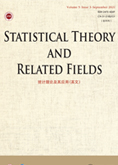References
- Cheung, Y. B. (2002). Zero-inflated models for regression analysis of count data: A study of growth and development. Statistics in Medicine, 21, 1462–1469. [Google Scholar]
- Crepon, B., & Duguet, E. (1997). Research and development, competition and innovation pseudo-maximum likelihood and simulated maximum likelihood methods applied to count data models with heterogeneity. Journal of Econometrics, 79, 355–378. [Google Scholar]
- Dagne, G. A. (2010). Bayesian semiparametric zero-inflated Poisson model for longitudinal count data. Mathematical Biosciences, 224, 126–130. [Google Scholar]
- Dempster, A. P., Laird, N. M., & Rubin, D. B. (1977). Maximum likelihood estimation from incomplete data via the EM algorithm (with discussion). Journal of the Royal Statistical Society, Series B, 39, 1–38. [Crossref], [Google Scholar]
- Faddy, M. (1998). Stochastic models for analysis of species abundance data. In D.J. Fletcher, L. Kavalieris, & B. F. J. Manly (Eds.), Statistics in Ecology and Environmental Monitoring 2: Decision Making and Risk Assessment in Biology (pp. 33–40). University of Otago Press. [Google Scholar]
- Feller, W. (1943). On a general class of contagious distributions. Annals of Mathematical Statistics, 16, 319–329. [Google Scholar]
- Gelman, A., Carlin, J. B., Stern, H. S., Dunson, B. D., Vehtari, A., & Rubin D. B. (2014). Bayesian data analysis (3rd ed.). Boca Raton, FL: CRC Press. [Google Scholar]
- Ghosh, S. K., Mukhopadhyay, P., & Lu, J. C. (2006). Bayesian analysis of zero-inflated regression models. Journal of Statistical Planning and Inference, 136, 1360–1375. [Google Scholar]
- Lambert, D. (1992). Zero-infated Poisson regression with application to defects in manufacturing. Technometrics, 34, 1–14. [Taylor & Francis Online], [Google Scholar]
- Lam, M. C., Ang, L. W., Tan, A. L., James, L., & Goh, K. T. (2011). Epidemiology and control of legionellosis, Singapore. Emerging Infectious Diseases, 17, 1209–1215. [Google Scholar]
- Liu, W. C., Tang, Y. C., & Xu, A. C. (2017). A zero-and-one inflated Poisson model and its application. Statistics and Its Interface, Accepted. [Google Scholar]
- Melkersson, M., & Rooth, D. (2000). Modeling female fertility using inflated count data models. Journal of Population Economics, 13, 189–203. [Google Scholar]
- Musio, M., Sauleau, E. A., & Buemi A. (2010). Bayesian semiparametric ZIP models with space-time interactions: An application to cancer registry data. Mathematical Medicine and Biology, 27, 181–194. [Google Scholar]
- Neyman, J. (1939). On a new class of contagious distributions applicable in entomology and bacteriology. Annals of Mathematical Statistics, 10, 35–57. [Google Scholar]
- Tanner, M., & Wong, W. (1987). The calculation of posterior distributions by data augmentation (with discussion). Journal of the American Statistical Association, 82, 528–550. [Taylor & Francis Online], [Google Scholar]
- Wu, C. F. J. (1983). On the convergence properties of the EM algorithm. The Annals of Statistics, 11, 95–103. [Google Scholar]
- Welsh, A., Cunningham, R., Donnelly, C., & Lindenmayer, D. (1996). Modeling the abundance of rare species: Statistical models for counts with extra zeros. Ecological Modelling, 88, 297–308. [Google Scholar]
- Xu, H. Y., Xie, M., & Goh, T. N. (2014). Objective bayes analysis of zero-inflated poisson distribution with application to healthcare data. IIE Transactions, 46, 843–852. [Taylor & Francis Online], [Google Scholar]
- Zhang, C., Tian, G.-L., & Ng, K.-W. (2016). Properties of the zero-and-one inflated Poisson distribution and likelihood-based inference methods. Statistics and Its Interface, 9, 11–32. [Google Scholar]








 yctang@stat.ecnu.edu.cn
yctang@stat.ecnu.edu.cn




 loading......
loading......